How to Visit Himba, Damara, San & Herero Tribes in Namibia
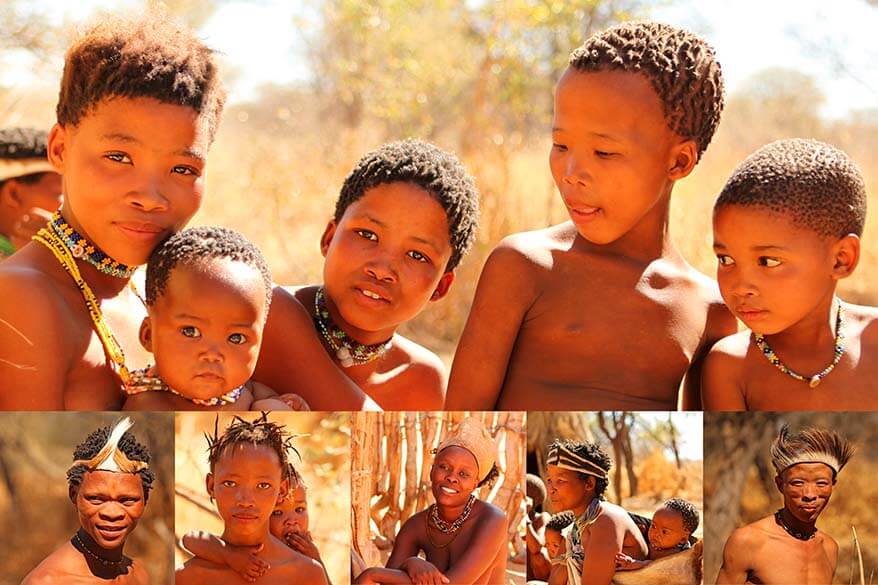
This site contains affiliate links, which means that we may earn a small commission, at no cost to you, for qualifying purchases. It supports the work that goes into keeping this content free. Thanks for reading! More info: Privacy Policy.
One of the highlights of an African trip is the possibility to meet the people of the indigenous tribes of Africa. When we were preparing our Namibia trip itinerary, we knew that we would want to meet the people from at least a few of the many local indigenous tribes in Namibia.
However, it was not very easy to find detailed information about where to see the Himba tribe, Damara, Herero, or San people in Namibia.
We all want to try and avoid the feeling of visiting a human zoo, yet we long to get to know other cultures and learn more about the habits of people whose lifestyle is so very different from ours. So in this article, I want to share our experience visiting the indigenous Namibian tribes.
Good to know: If you have something against nudity, you shouldn’t read this article further. In that case, I also urge you not to visit the indigenous tribes of Africa, as there is really no way around it. This is who those people are and how they live. For this article about the Namibia tribes, I tried to select pictures without too much nakedness in them, but it was not always possible.
Overview of the indigenous tribes we visited in Namibia:

Himba Tribe
The Himba are semi-nomadic indigenous people living mainly in the Damaraland region in Northern Namibia.
Himba tribe managed to avoid too much outside influence and preserve the traditional lifestyle. It’s the only people from the indigenous tribes we visited in Namibia who really still live the way their ancestors did centuries ago. They do not put up a show for the tourists. Well, at least not the Himba people we visited.
If you see a travel brochure with pictures from Namibia, the chances are high that you’ll see pictures of the Himba. But how and where to find Himba tribes in Namibia? Read on!
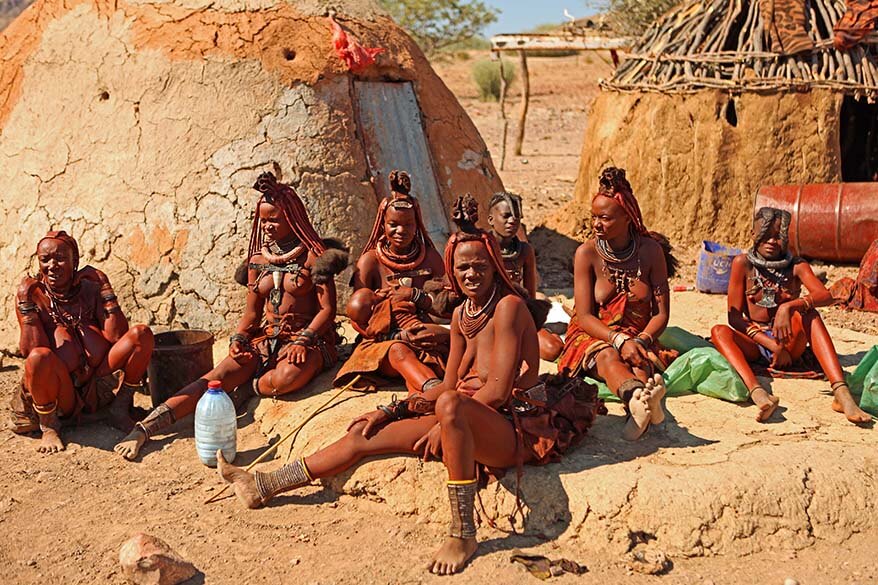
Where to see Himba people in Namibia
When preparing for our Namibia trip, we read about a Himba orphanage, Otijkandero Orphan Village, that one could visit on the way from Twyfelfontein to Etosha National Park (somewhere between Kamanjab and Outjo). But this was not really the authentic experience we were looking for.
I also read that one could take a day trip to visit the Himba North of Palmwag, but the reviews were talking about a long day trip of 10 hours on bumpy roads, so this option wasn’t for us either.
If you read more about our trip to Namibia, then you know that we were traveling in Namibia with three young kids, so long day trips with not much to see were out of the question for us.
And then there was an option to see Himbas that our travel agent proposed to book for us, but it was such an expensive day trip that we didn’t even look into it further.
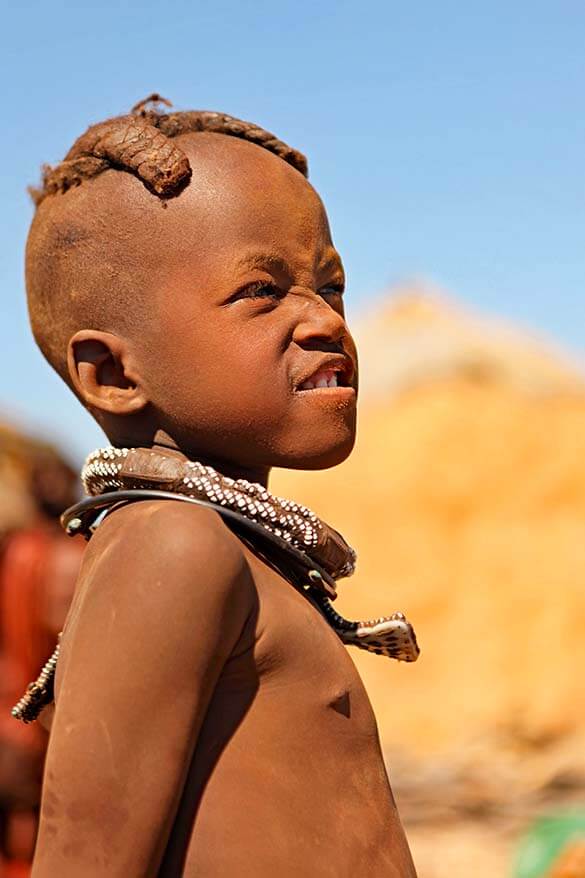
So where to find an authentic Himba tribe in Namibia?
We were staying in Palmwag for a couple of days, and we knew that there are a lot of guided safari rides and also Himba tours available from there. As I said before, we thought that a long day trip of over 10 hours was the only option to see the Himbas near Palmwag.
But upon arrival at the Palmwag Lodge, we found out that there was a Himba village nearby and that the lodge was organizing a day tour that included a visit to the Himbas North of Palmwag.
It appears that the Himba village was not that far at all. Furthermore, the road to get there was a regular gravel road like anywhere else in Namibia. In addition, the day tour was more about safari and visiting the Himba village and did not involve that much driving and spending endless hours in the car. So after talking to the guides, we decided to give it a try and booked this day trip.
I don’t remember the exact price of the tour anymore, but I know that it was 1/4th of the price of the Himba tour that travel agents wanted to sell to us. On top of that, the kids under 6 were free of charge, so we would need to pay for 2 adults only.
Later on, they came back on this and said that we should pay a bit more because we had three kids under 6 and there was nobody else going on the same tour that day. And so if we wanted to do it and have the whole jeep to ourselves, we had to pay an additional price of one child. It was still more than worth it.
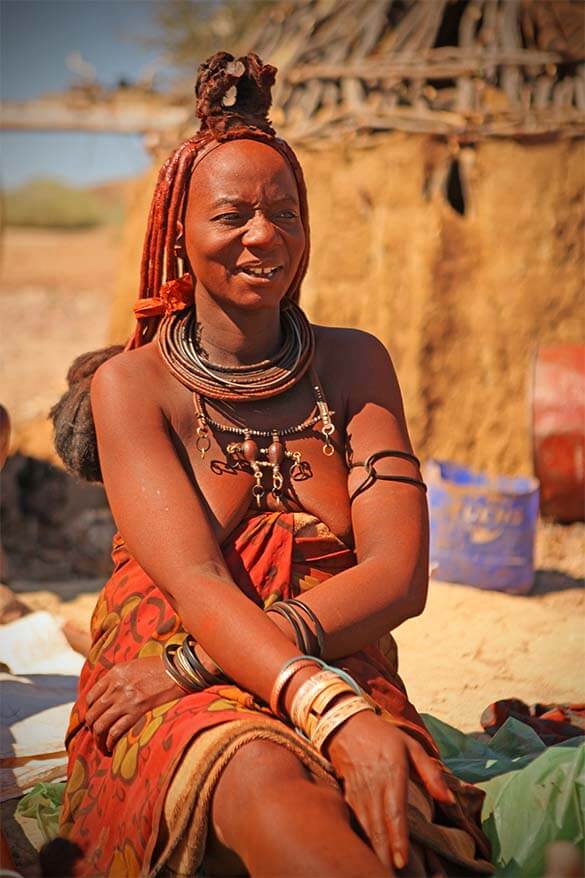
Visiting Himba and Damaraland safari day trip with kids
Our day started with a guided Damaraland safari morning tour, followed by a visit to the Himba village, more safari, lunch, and then again safari drive till sunset. We started at 7 AM and were back around 5-6 PM. We had an amazing day.
Yes, it was a lot of time spent sitting in the car, but we were mainly looking for safari animals along the way. Also, before our Namibian trip, we bought binoculars for all three of our kids so they were very engaged in looking for animals every time we went on a safari ride. We saw a lot of wildlife which helped to keep the kids entertained.
Looking for more tips? Check our post with all kinds of practical information and tips for your first safari.
We spent about an hour at the Himba village, followed by some serious off-road driving over the dry river bed and a very bumpy savannah following a herd of desert elephants.
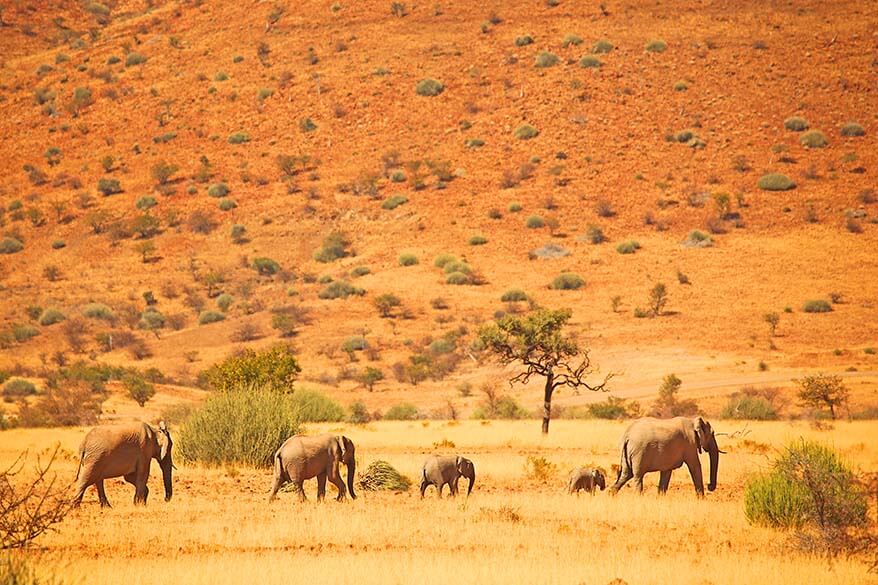
We then had one of the most memorable meals that you can only have in Africa: a picnic lunch in the savannah while watching the elephants from a safe distance.
In the afternoon we continued looking for animals, and the day was over before we knew it. Our kids of 3, 3, and 5 years handled this day tour extremely well. Although the kids were a bit too wild and too enthusiastic with the goats of the Himba… But luckily the Himba people were super understanding, patient, and friendly with our kids.
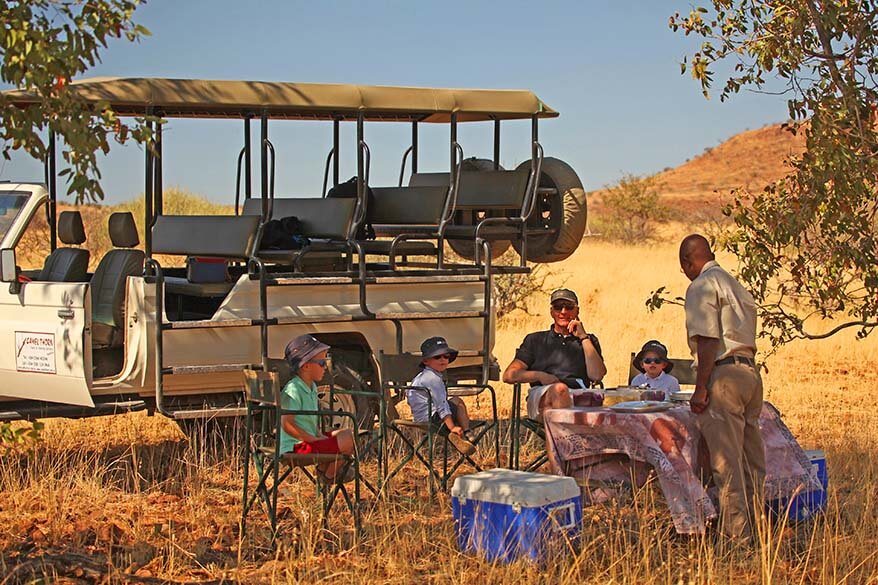
Our visit to the Himba tribe in Damaraland
The Himba village that we visited was more of a family farm. The family consisted of a man, his mom (the father was dead), his three wives, and their 27 (yes, you read it right!) children.
We understood that every ‘village’ is actually just one family’s home. And since the Himbas are semi-nomadic, they move and build new ‘villages’ every time.
The Himba clans are led by the eldest man, sons live with their father’s family and the daughters move to live with their husband when they get married.
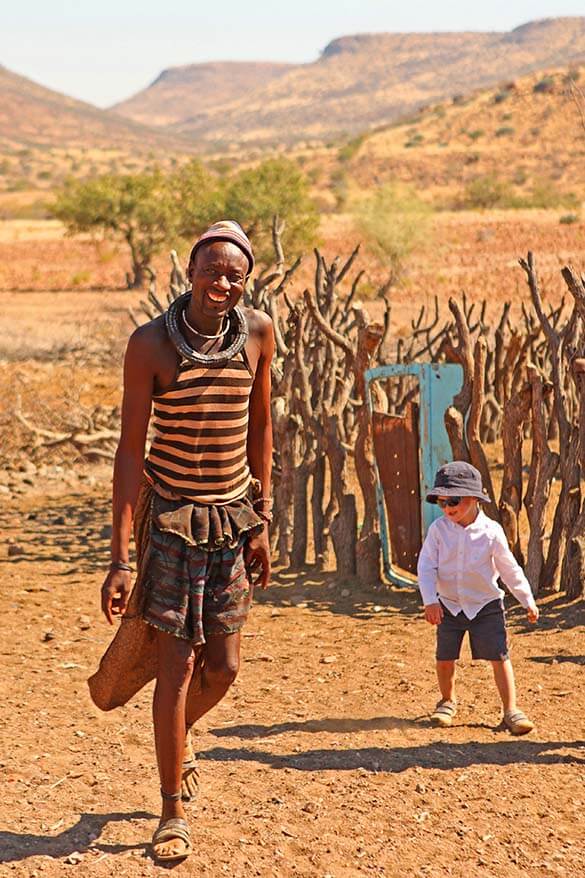
The Himba village itself was not more than a collection of tiny mud huts, a fireplace in the middle where everyone seemed to be hanging around the whole day, and a small fenced area for the goats and the chicken.
We were told that they had more cattle a bit further away, but we didn’t see it. That’s pretty much all they have, and all that counts.

The Himba women were all dressed in traditional clothing and most attention seems to be given to the jewelry and the hair.
Hairstyle and jewelry are very important for the Himba. It indicates the age and social status of each person within the community.
The hair of the women is covered in red mud and they also use some kind of a red substance to protect their skin from the sun.
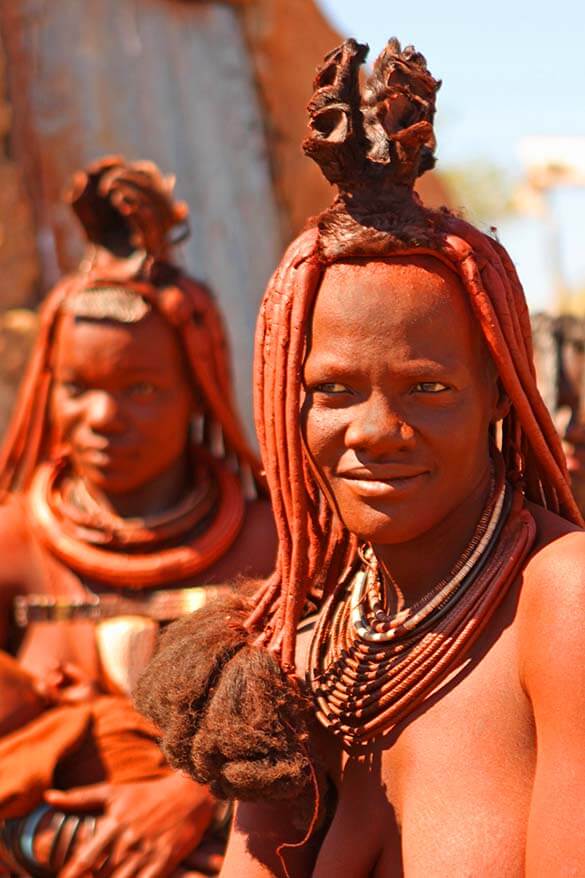
The visit to the Himbas was very relaxed. Our driver/guide was very familiar with the family and helped us all communicate. Afterwards we found out that he also came from the Himba tribe.
The Himba people were extremely friendly, their kids showed our kids some goats and chicken, and they had just about as many questions for us as we had for them.
It really felt like a very genuine visit to a very special family.
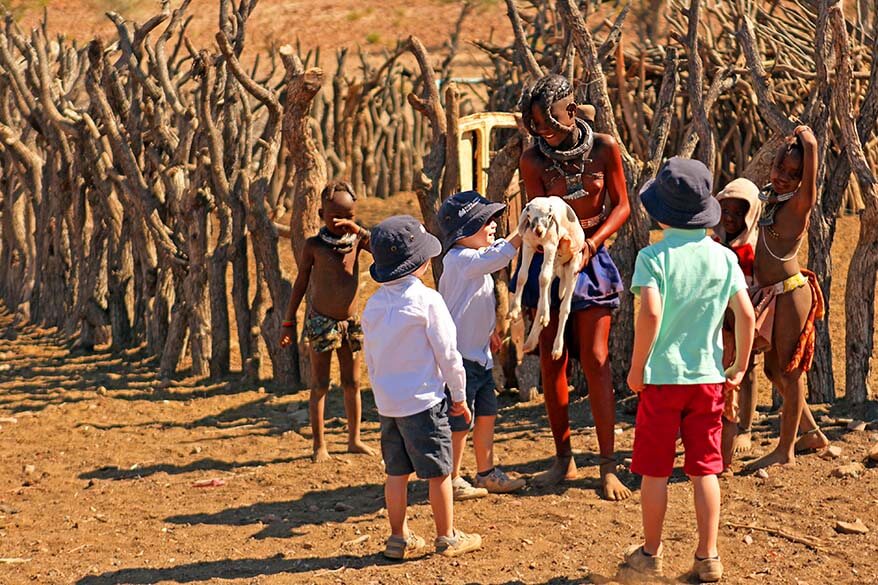
Of course, we were expected to buy some hand-made souvenirs they presented to us at the end of the visit, which we did. That’s probably the only source of income that the family had, apart from some cattle which serves more as a way to feed the family.
So if you are visiting any indigenous tribes in Africa, think of how you can support them without giving charity. People really appreciate it if you genuinely like a hand-made souvenir that they or their kids made.
If you are looking for unique gifts to bring home, this is a great opportunity to get something truly special!
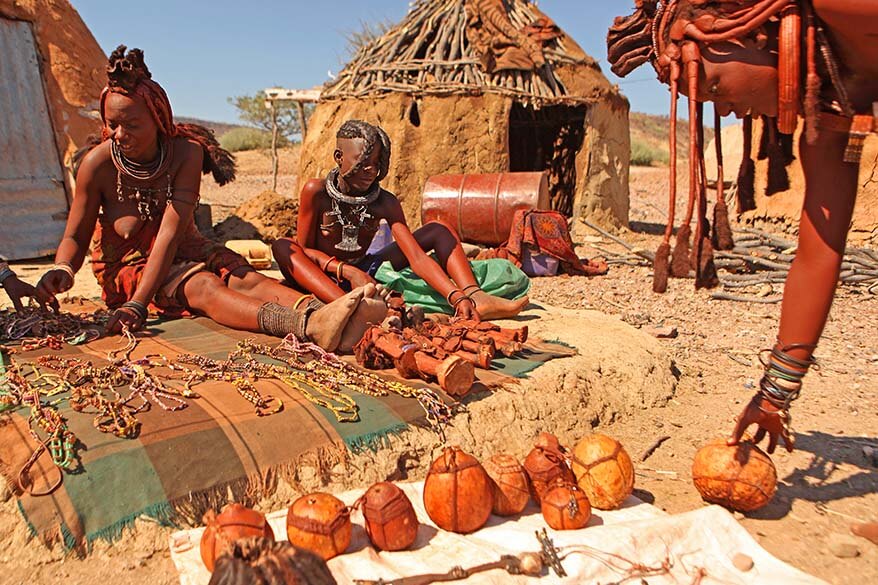
Can you still see the Himba near Palmwag?
Since Himba are nomadic people, it can very well be that the village we visited is long gone by now. Or maybe there are many other new villages to be visited nearby…
TIP: If you want to be sure you can see Himba North of Palmwag, you best contact the Palmwag Lodge in advance for more up-to-date information. Alternatively, try some other lodges in the area too. It can very well be that they also offer similar day trips.
I can recommend the beautiful Grootberg Lodge. It’s not that far from Palmwag and has similar day trip possibilities, but it’s a much nicer lodge and it’s better managed.
Alternatively, check out the Etendeka Mountain Camp – it’s a beautiful tented accommodation in the same area as the two lodges I mentioned before, and it has really amazing reviews.
Visiting Etosha National Park as well? Check our guide to the best places to stay in Etosha National Park.
Meeting the Damara people in Namibia
The Damara is one of the oldest tribes in Namibia with a quite significant population of about 100,000 people (+-9% of the Namibian population).
However, their culture and habits haven’t been preserved very well and they seem to be much more adapted to the more modern lifestyle than the Himbas.
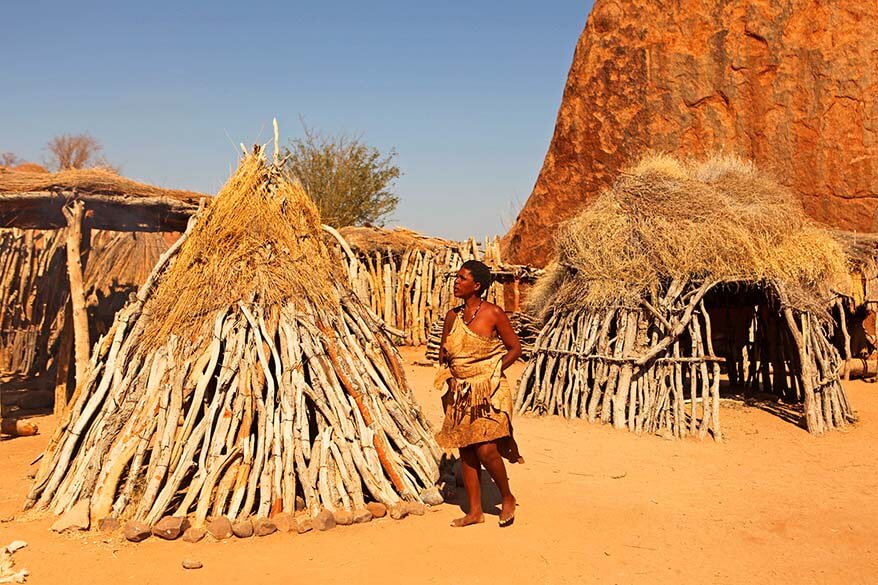
Damara Living Museum near Twyfelfontein
One of the few places to experience the traditional Damara culture is the Damara Living Museum near Twyfelfontein. It’s an open-air museum with a staff of some 30 people who come to work here every day showing tourists how the Damara life used to be in the past.
You have two options for a visit at the Damara living museum, both with an obligatory guide: the village tour or the combination of the village and the bush tour.
We opted for the village tour since most reviews we found on the Internet said that the bush tour was not really worth the time or the money.
The ‘village’ is a small collection of traditional huts and workplaces, each specializing in one aspect of the traditional Damara lifestyle. The guide takes you from one place to another and you can see how the Damara people make jewelry, clothing, how they start a fire using only sand and some dry sticks…
We also met the ‘medicine’ expert who explained about all kinds of plants they use for cure. At the end of the visit, we could see a little show. It was a performance of an old Damara folk tale with lots of dancing and singing. Very impressive!
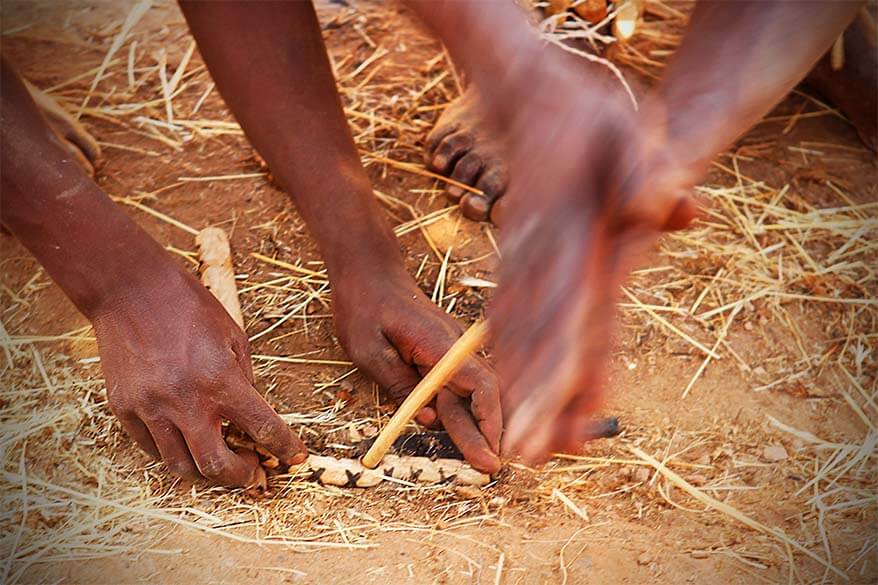
It was a very informative visit and it was nice to see how the life of Damara used to be, but it wasn’t comparable to visiting a real living village like the one of the Himbas.
The Damara people we met were also very distant, not friendly at all, and you could see that this was just their job with a single purpose of making money from tourists.
If only they had done their best to at least pretend they liked what they were doing, it might have been a much more enjoyable experience. Or maybe they just had a really bad day…
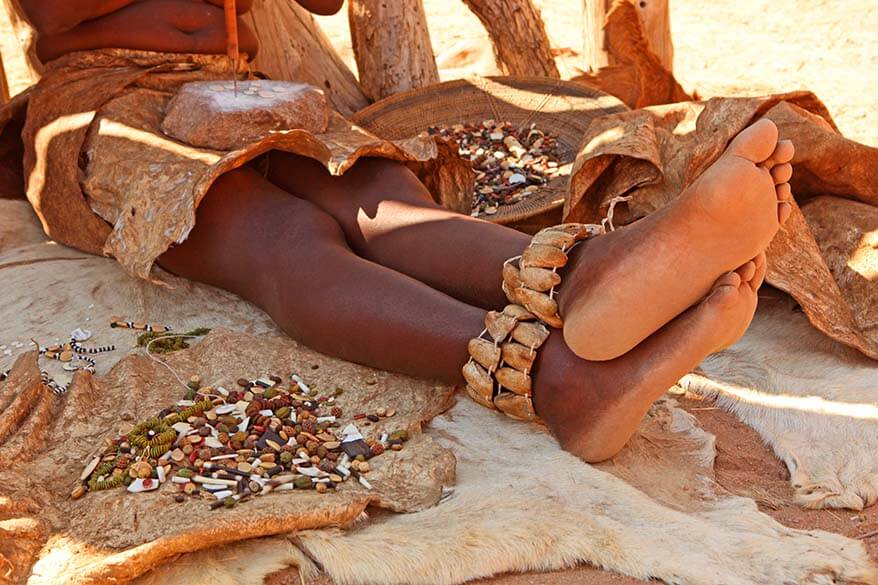
The ‘living museum’ concept apparently has become a big business in Namibia.
They already have six different museums, all in Northern Namibia, where you can get acquainted with all kinds of different Namibian tribes: Ju/‘Hoansi-San, also the little hunters of San, Mafwe, Mbunza, Damara, and Ovahimba.
You can find more information for your visit to one of the living museums on their official website.
READ ALSO: Best Places to Visit in Namibia
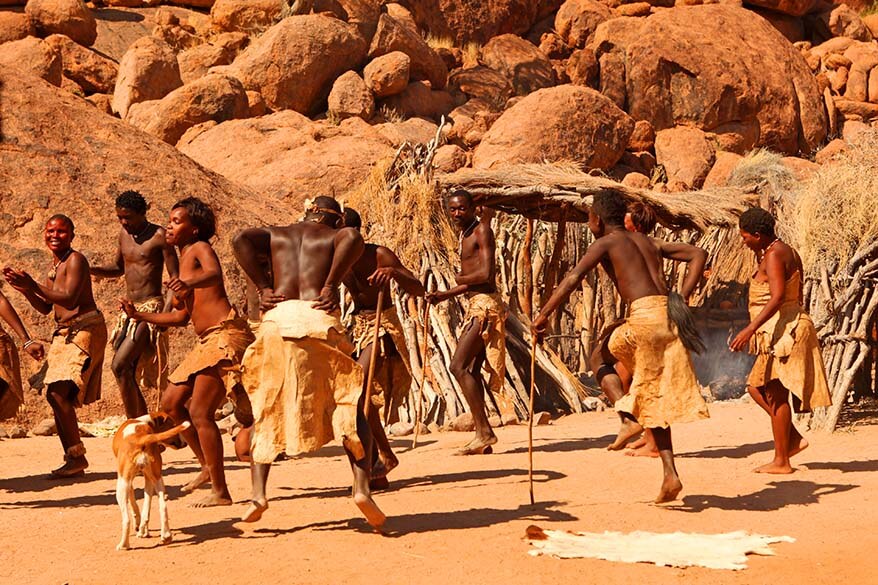
Bushmen – San people in Namibia
The San people, more often referred to as Bushmen, are one of the oldest indigenous hunter tribes in Southern Africa. They live in South Africa, Namibia, Botswana, Angola, Zambia, and other neighboring countries.
The San have long switched to farming now, but a lot of their traditional lifestyle appears to still be preserved. Bushmen still lead nomadic life and live without any modern comforts.
Most San settlements were a bit out of the way on our Namibian trip, so we didn’t really plan to see the Bushmen in Namibia. But then the opportunity presented itself, and so the San were the third indigenous tribe we visited in Namibia.
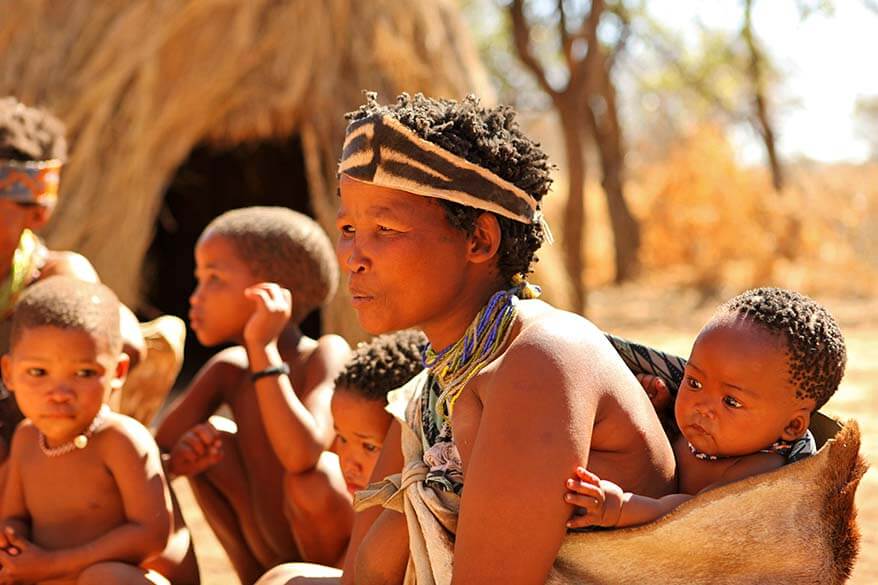
Visiting the San village at Erindi Private Game Reserve
Update: One of our readers let us know that the San people have left Erindi and moved back to their homeland. So it’s no longer possible to meet San people here.
Erindi Private Game reserve was one of the favorite stops on our Namibia trip. They have the most beautiful terrace overlooking a very active waterhole with hippos, crocodiles, elephants, and many other wild animals. It’s almost as good for wildlife viewing as Okaukuejo in Etosha National Park, but way more luxurious.
We didn’t know in advance that there are several San families living at Erindi. We came here for the lodge and for the fantastic game drives they offer in their huge private game reserve.
The short trip to the San Village is just one of the many activities you can do at the Erindi Private Game Reserve, and – according to their website – it’s only offered to their overnight guests.
We really enjoyed this short visit. It was nice to meet a community with so many children. I read that the San children are not expected to contribute to the community, so they have a really nice childhood with lots of time to play, explore, and learn from the elders of the tribe.
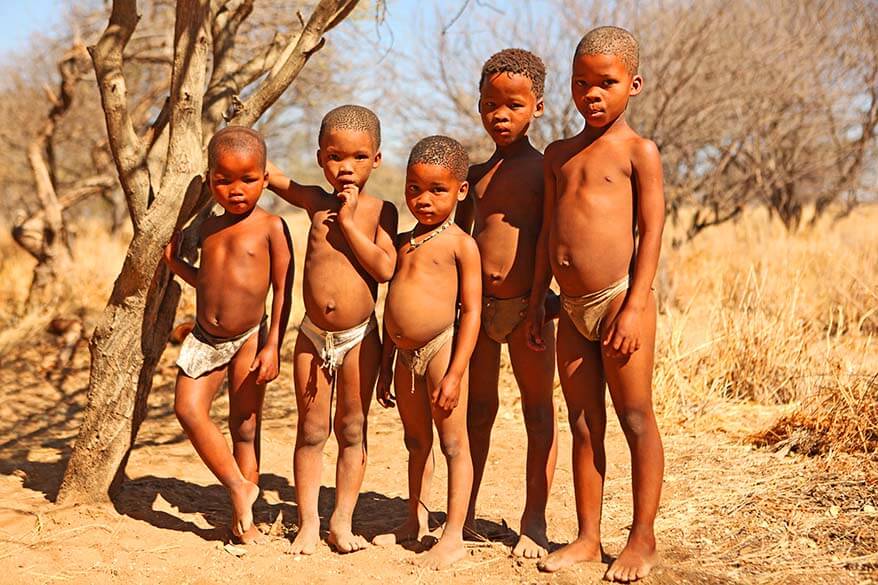
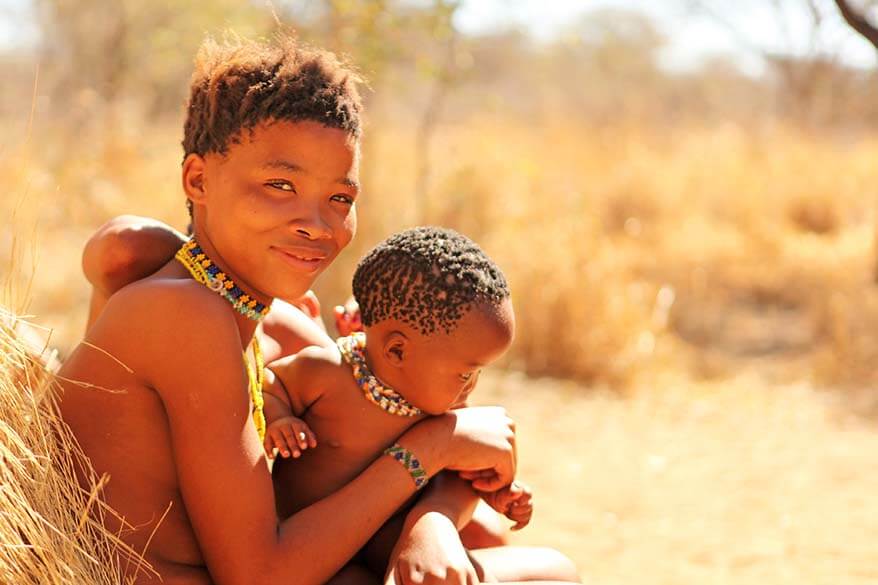
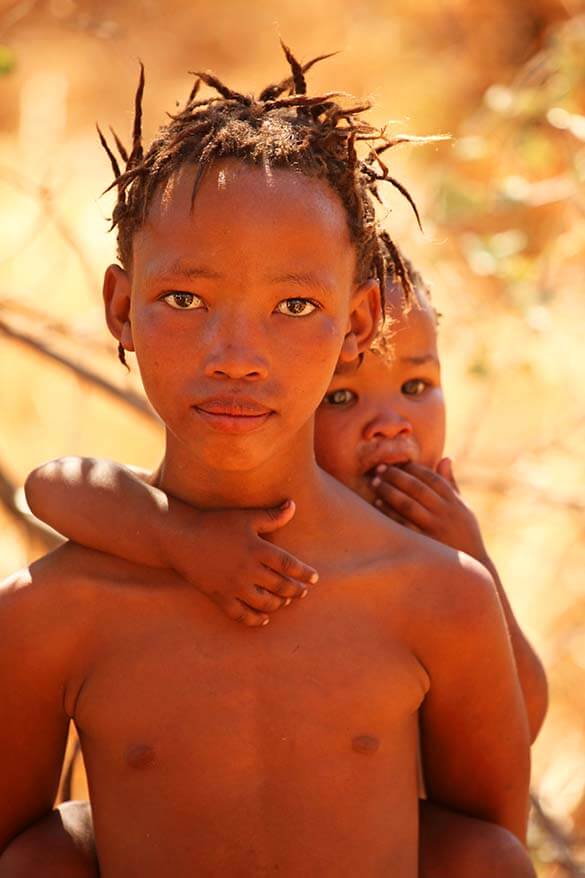
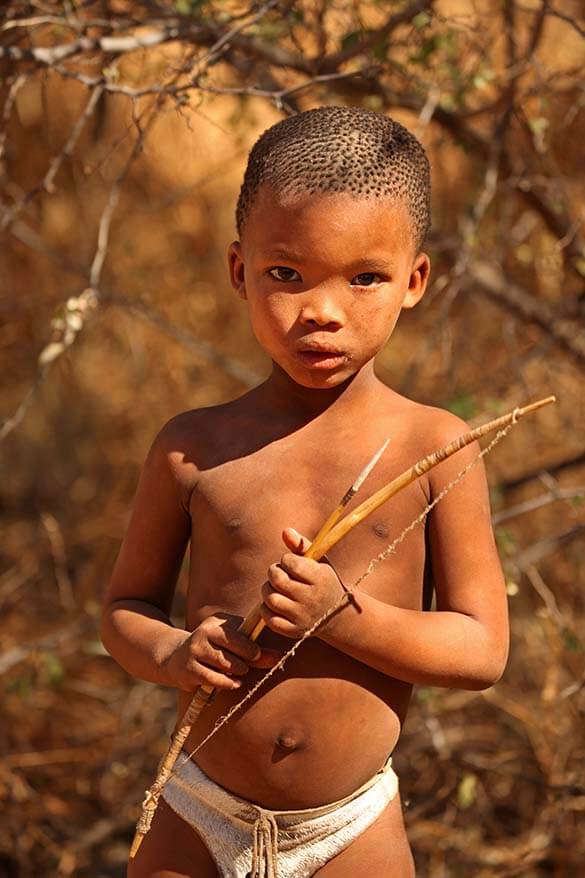
The Bushmen also had a ‘medicine man’ who explained about the plants they use when someone gets sick. They also made fire without the use of matches, just like the Damara people did. They showed us how they used to hunt and how they teach children to read the signs and follow wildlife.
While it was a real community showing their daily life to us, it still felt to be much more tailored for tourists than the Himba visit. It was also not a real village where they live, just a place they come to every day, in collaboration with the reserve and their financial support.
On the other hand, the people were really friendly and we really enjoyed getting acquainted with yet another African tribe and their culture.
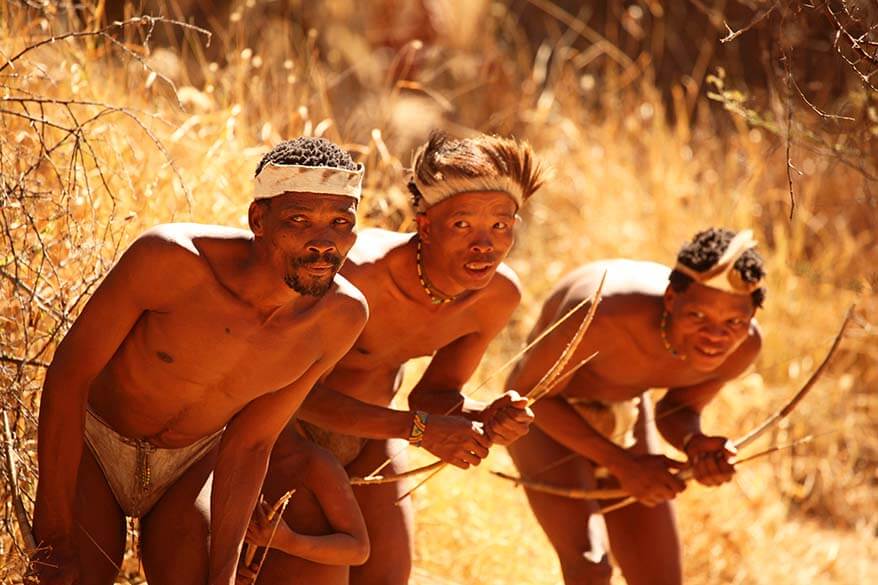
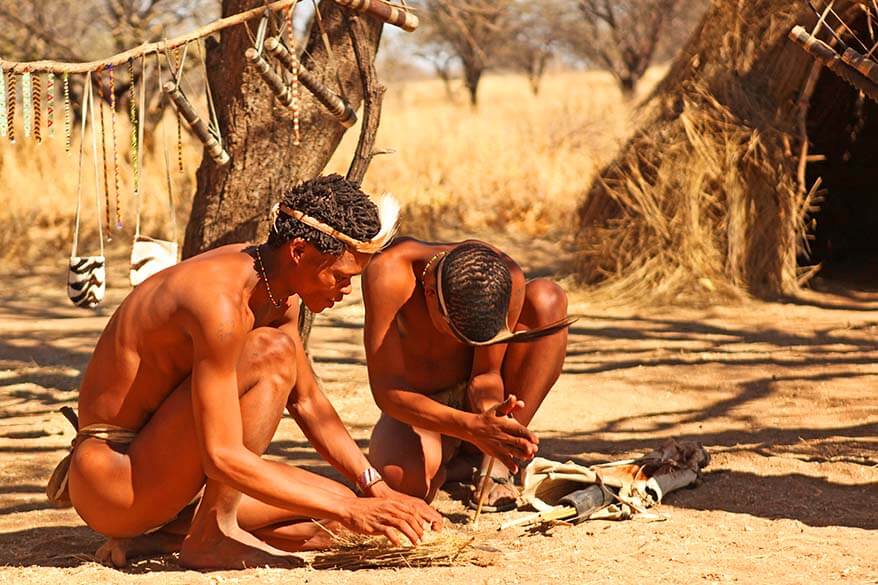
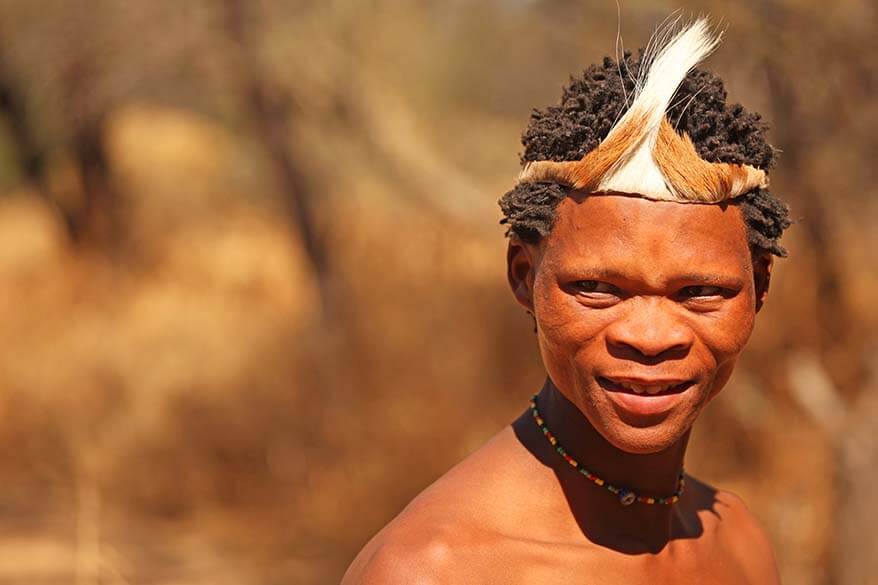
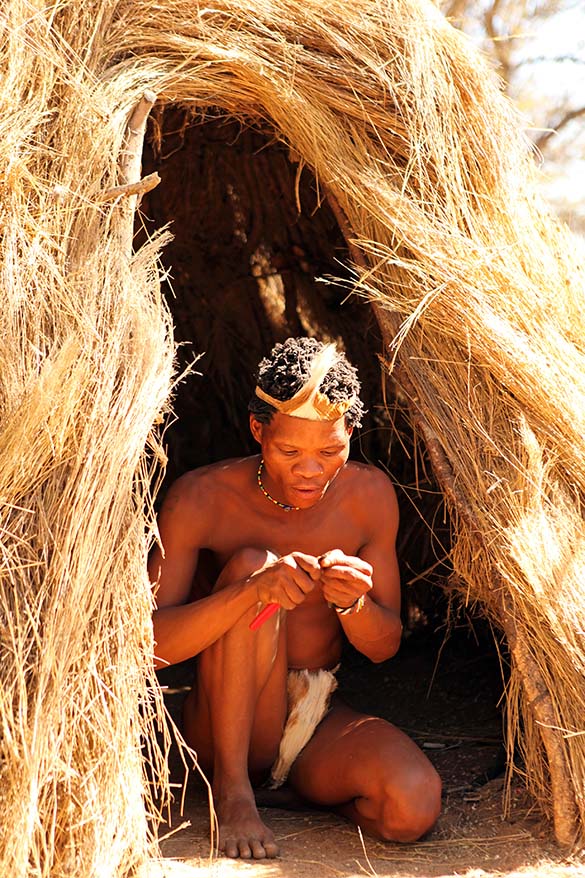
Herero tribe in Namibia
We hadn’t planned to visit the Herero people in Namibia, but we saw many Herero villages and people while driving on the road from Swakopmund to Twyfelfontein.
The Herero people stand out from the other tribes because of their colonial-style clothing. This tribe also seemed to be the proudest of all the Namibia people we met on our trip.
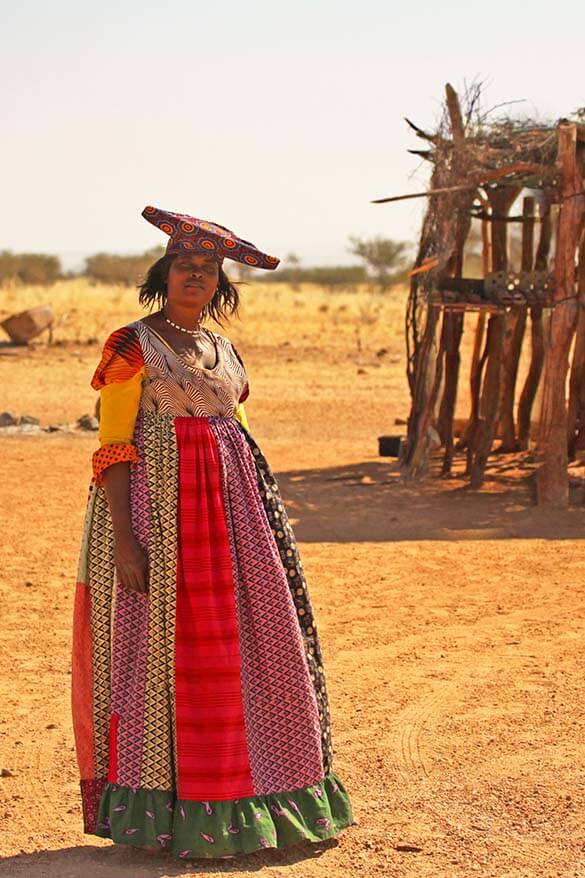
In search of indigenous tribes in Namibia – our tips
- If you are looking for a simple way to see the indigenous tribes in Namibia, then the Damara living museum is probably one of the easiest accessible places to do this. It’s very close to the Twyfelfontein UNESCO site which many tourists visit anyway, and it can easily be combined. If you are road-tripping through Northern Namibia, then the other living museums might be a good option as well.
- If, however, you are looking for a more authentic experience, you should consider visiting a real Himba or Damara village. My best advice would be to contact the lodges to the West of Etosha National Park (see above – the Himba section – for suggestions). Ask them what the possibilities are.
- For a truly authentic experience, you can also try to just stop at one of the Herero villages you’ll pass on your way. However, I honestly don’t know how those people would react or how you’d communicate with them without a translator…
- If you want to visit Namibia, meet local people, and see the beautiful landscapes and wildlife, but don’t know where to start, you may want to visit Namibia with an organized tour.
Have you been to Namibia and visited Himba, San, Damara, or another indigenous tribe? Please share your experience and location by leaving a comment under this article. You’ll help other travelers looking for a similar experience.
READ ALSO: Namibia Travel Tips
TIP: Did you find this guide helpful? Bookmark this post for later, share it with your friends, and save it to Pinterest to inspire your next trip.
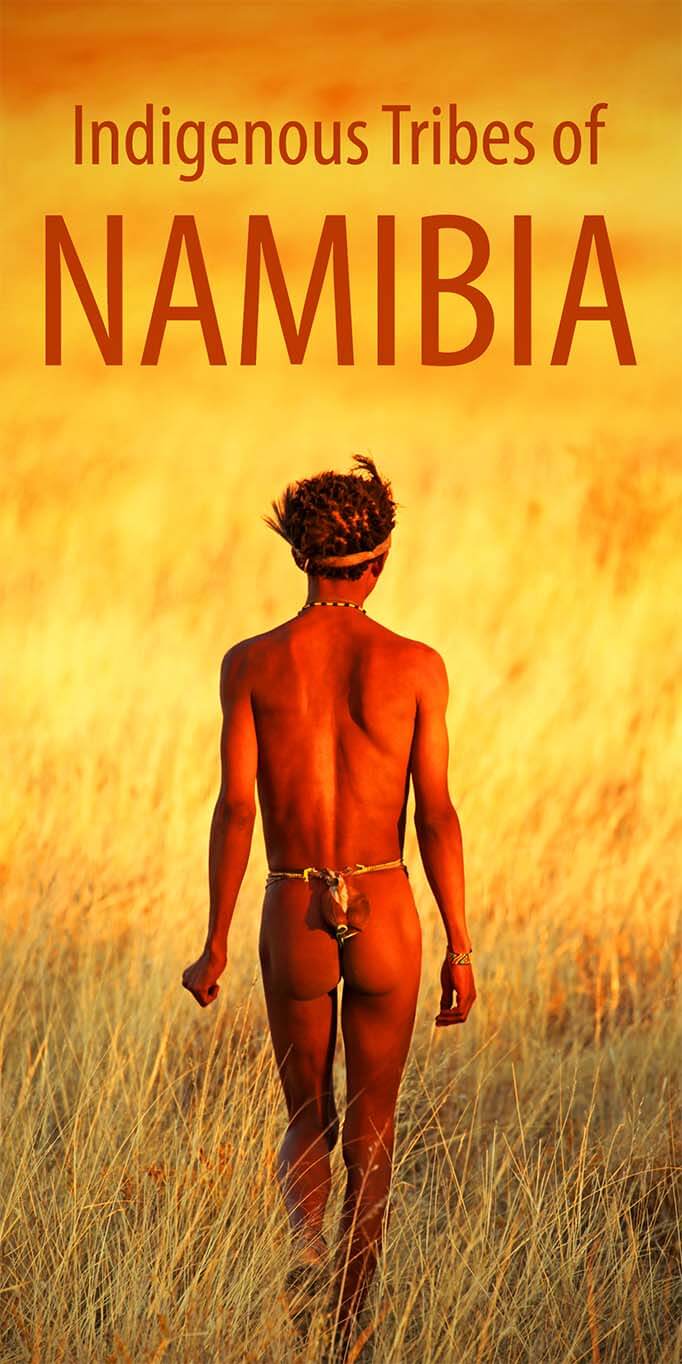
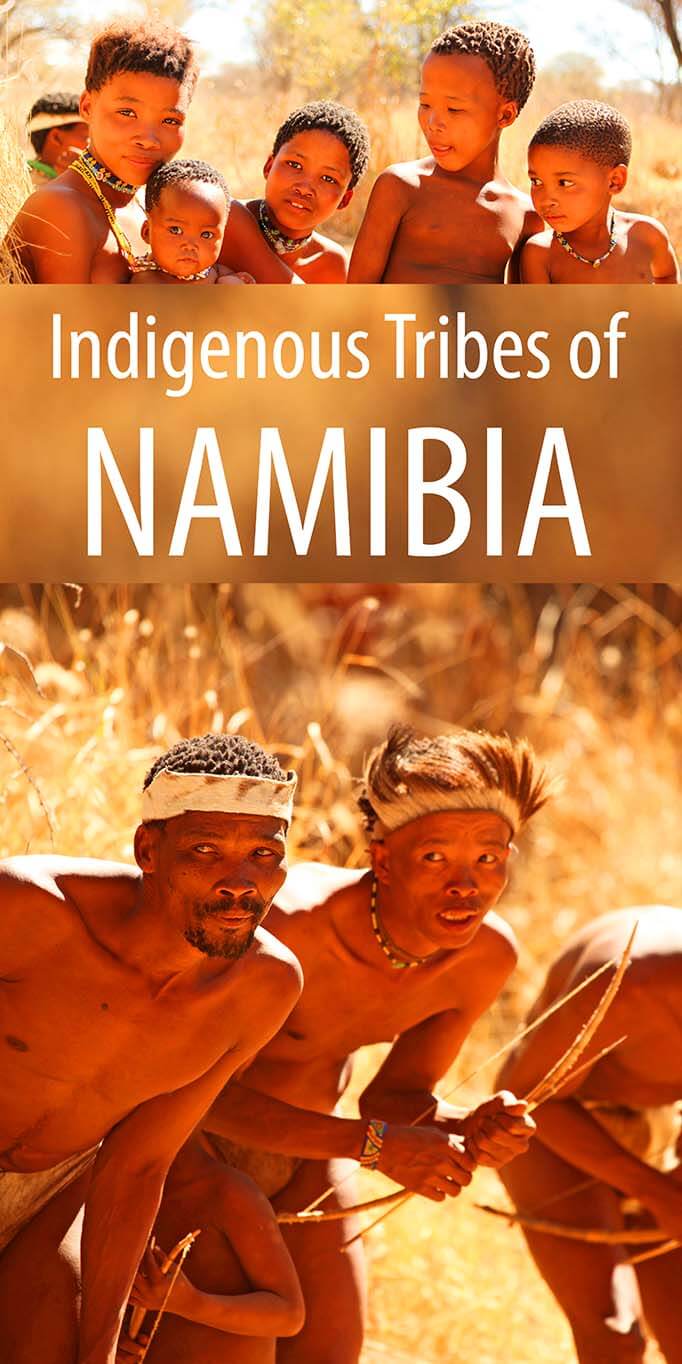



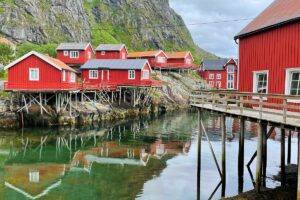

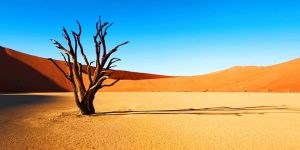
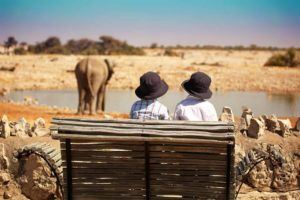
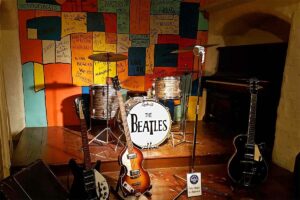
Hey! My friend and I are coming to Namibia in June. We are wondering how you got from the desert to the airport? And how you got to the different spots like tribe, desert, etc and the best accommodations? Do we need to contact different guides to pick us up from each place? We have around 4 days for everything. Thanks so much!
Dear Cameron, you can find all this information in our Namibia trip itinerary. We rented a car and made a road trip.
I really wouldn’t know how to visit Namibia in just 4 days. The country is huge. I assume you could find some guided day tours from Windhoek, but you wouldn’t get to any of the nicest places that way. Ideally, you book a multi-day tour so that you can see more without sitting in the car for hours and hours. Take a look on Viator; there are a couple of nice 3-4 day tours. Also, book asap!!! June is very high season.
Have a great trip!
Thx for sharing. Very helpfull indeed. March ’23 update regarding Erindi Game Reserve (EGR):
EGR responded: Unfortunately we no longer have the San people at EGR, since the covid pandemic thay have relocated back to their homeland of Tsumkwe in the North of Namibia. We also do not offer to see the San art as some tourists have damaged the paintings.
Thanks for the update, Maarten.
It’s not surprising at all – these people are nomadic after all. And I guess it’s better for them to have a normal life and not depend on tourists.
bonjour
j’ai adoré votre reportages les tribus et vous remercie de nous faire partager votre expérience
je pars ds un mois en Namibie je souhaite voir et partager un peu de temps avec une tribu Himba j’ai vu que sur la route il y a avait omusaona village mais je ne sais pas comment visiter ce village et trouver un guide avez vous un idée? nous ne dormirons pas a coté on sera juste de passage qq heures
je vous remercie
Hi Prajs, leaving a comment in French on an English-speaking blog is not the best idea. I just found it in our spam folder by complete coincidence…
Anyway, I am not familiar with Omusaona village. If you can’t find information online, the best advise I can give you is to inquire locally, at the lodges where you will be staying.
Have a great trip!
@Jurga,
thank you for the reponse
Thank you for the tips. I actually was wondering if the tribal people would like to receive pictures of themselves taken with a polaroid camera. In other parts of the world, local people were really very happy .I would like to offer them some pictures when I photograph them: plan is for next summer. What do you think, would it be a good idea?
Also, I used to shoot with a professional camera, but the weight was killing the experience. Are there light cameras that can zoom decently(200mm?) based on your research? Budget is not the issue, the weight is,
Many thanks
Hi Anda, I really don’t know about the Polaroid; some people might enjoy it, but why not simply ask them when you are there.
As for the camera, I know what you mean about the weight. I’m not sure how light you want it to be, but the lighter ones tend to also be cheaper and likely lesser quality than what you’ve been used to it. Anyway, this model from Panasonic has a zoom of up to 600mm and is quite lightweight. For better quality (but also more weight, unfortunately), take a look at Nikon Coolpix p1000 series (or 900/950). These cameras are comparable to the professional DSLRs in terms of weight and quality (and the zoom is insane!), but the biggest advantage here is that you have one lens for everything. So you only have to pack one camera. It won’t help you much if you find it heavy to hold, but it will help if you are mainly worried about the packing weight of the camera and all the lenses. We ourselves just bought the p1000 and I can’t wait to try it out on safari.
Hope this helps.
@Jurga, thank you so much. 1.5 kilos for the camera is a lot. My old d700 is probably the same weight. Will check the Panasonic too. Thanks
Oh and l asked in case it won’t be a good idea, not to carry the Polaroid camera on.
Yes, I understand that it’s not ideal to carry a big heavy camera. Hope you find something lighter that still offers decent quality.
As for the Polaroid, I really don’t know what to say. You can make it easy for yourself and just not pack it. I suppose it also depends on where you are traveling exactly and how many opportunities you’ll actually have to meet indigenous people. In our case, it was 3 times in an entire month, so I don’t think I would have wanted to pack something extra for that. But if it makes you happy to potentially make other people happy, then it might be worth it. Maybe try googling something like that and see if you find some internet discussions about this topic.
Dear Jurga
We’re planning a trip into Nambia and like to discover the cultures like the Himba. I would like to now if it’s possible to spend a night with the Himbatribe (like we did before with tribes in Malaysia and Thailand) Do you have a name or any contact details of your guide. Maybe I can reach him for further questions or details.
Many thanks in advance
Wim Boel
Belgium
Hi Wim, unfortunately, I don’t have any contact information for guides. We visited the Himba people with a local guide from Palmwag Lodge where we stayed for a few days. We didn’t book anything in advance – just inquired upon arrival at the lodge and they arranged a day trip for us.
Himba are nomadic people and I think you just have to accept the fact that it’s hard to plan much in advance if you want to visit a real Himba village. I’m not sure about the possibility to stay with them either – the ‘village’ we visited was actually a place where one family lived and the few huts they had were hardly big enough for all of them to sleep in.
Sorry, I can’t help you more. Good luck!
I intend to visit Namibia with the purpose of visiting the Damara and Himba people the later being the most culturally inclined. From what I have seen the Damaras are not that different from other tribes cultural from South Africa. I would like to see mostly the Himba and Bushmen.
Please provide me with full information as I will be travelling from Cape Town. IF YOU HAVE A CONTACT FROM CAPE TOWN PLEASE PROVIDE ME WITH HIS / HER PARTICULARS.
Hi Mandla, all the information we can provide is already in the article. If you are looking for a tour, there are multi-day tours that visit some tribes. For example, this tour says they visit Himba, Damara, and Herero people.
I can’t really help you more than that. All the best!
I have always been fascinated by Namibia. Such interesting land and culture.
Agree, Namibia is surely a very fascinating country with a big mix of cultures and landscapes.
This is the best statement from what I have read so far. Everyone is trying to make Namibia sound so rural all around and make it like the Himba people represent the Namibian culture. The Himba are not a spectacle and I hope everyone trying to go there to experience their culture really is doing that and not just treating them like a spectacle and demean them when they come back. Enjoy my people…dont degrade them. Thank you
Thank you, Thandiwe. That’s indeed something we have to be careful with and remember that we are visiting real people in their homes and not some dressed up actors entertaining tourists. It’s a thin line, I find, but I hope that responsible tourists are able to make informed decisions and at all times stay respectful to local culture, habits, and -above all- each and every individual person that we meet during our travels.
Hi Jurga
What a truly wonderful report of your experiences. Thank you so much. I’m a solo female traveller (60+) from the UK & am going to Namibia for 24 days in Jan/Feb 2019.
I’m interested to see the ‘big ticket’ places that all the tourists do.
However, I am actually more interested in people/culture & getting to places where tourists don’t go too much.
I’ll be driving a SUV (a 4 x 4 would be a problem for me as I couldn’t physically change a wheel & my driving skills are definitely not up to a 4 x 4).
The Himba people are definitely a ‘must’ for me & it looks as though Palmwag Lodge or somewhere nearby might work (roads should be OK up to this point I think).
I want to get up to the river area around Rundu so I should get to see the San (Bushmen) people.
Twyfelfontein is on my planned route so that will add the Damara people for me.
There seem to be lots of Herero villages in Damaraland so that should be easy.
Thank you again for sharing your experiences.
I am starting to get excited now……….
(I’m now going to click through to your various links for other tips)
Hi Christine, your trip sounds really exciting, especially taking into an account that you’re traveling on your own. I really don’t know what to tell you about the car. I understand your choice for an SUV rather than a 4WD, but the areas you’re planning to explore can be quite difficult to drive to, especially if you’re unlucky and it has rained a lot… Even in dry season, I think a 4WD is a must in Namibia… Try to at least rent a car with high clearance, so the biggest you think you can handle…
Try to read some of our other posts indeed and see if it gives you a better idea of what to expect. You might be driving for hours without meeting anyone, especially in the South and in the North, so keep that in mind.
It would be great if you could come back here and share your experience after the trip. I’m sure it would help many other people looking for similar information.
Thanks and have a great and safe trip!
I enjoyed this blog. Thank you for sharing. I hope one day to experience something like this
Hi Tracy, glad you enjoyed the article. It’s becoming more and more difficult to find any indigenous tribes and people leading a lifestyle as their ancestors used to hundreds of years ago… The world is evolving and changing and so if you ever want to experience something like this, you’d have to be quick. Unfortunately, in many places in the world, experiences like this are becoming more of a tourist attraction rather than an actual way of living… Also in Namibia, nowadays it’s easier to visit a ‘living museum’ as they call it, than to find a real nomadic tribe of indigenous people…
This information of these tribes are quite interesting, being I have indian ancestor within my family, I can relate to their customs, I enjoyed this article very much.
Hi Jurga, I am Harry, I am going to travel Namibia soon. I read your blog and found that you have an amazing Himba and Damaraland safari day trip. I would interest to do a day trip as you. Could you tell me the place or tour company that you join this tour? I am a traveler by public transportation only. Appreciate your help.
Regards,
Hi Harry, did you research public transport in Namibia??? I haven’t seen one single bus outside Windhoek and a few other towns in more than 4 weeks… We once talked to some people who worked at the hotel and had family on the other side of the country. They said sometimes a bus wouldn’t come even if scheduled, so they would have to postpone the trip home with a few days, etc. Namibia is very very very rural and traveling individually without a car is difficult to imagine honestly. You can drive 2-3 hours and never meet another car in some areas. So keep this in mind or you will just waste your time. Even if you would find a bus to bring you from point A to point B, without a car you won’t see much.
The best way to travel on a budget is to join an organised camping tour. There are many options, you just have to research.
As for Damaraland and Himba, it’s even more difficult than most other areas because it’s really remote. I really think that your best bet is to look for an organised tour, one that includes a visit to the Himba village. Himba are nomadic people, so the places where they could be found a year or even just a month ago might have changed. You would need to contact some local lodges in Damaraland and enquire about current situation and possibilities. But then again, you cannot get to those lodges by public transport.
Hope this helps.
Wow!! This is a great review. I am a global public health graduate student at the University of Michigan and my class team is writing a case study on the UNESCO heritage sites in Namibia. I am so happy to hear a first hand experience! I’m so curious about your adventure as you have been recently. Do you know of any other people who have done something similar to you ie: blog or review? Do you have pictures you would be willing to let us use of the sites, people, heritage practices, or handmade goods? Would you be willing to chat with me about the experience?
Keep up the good work!
Hi Brittany, thank you and glad you found this useful. I haven’t seen any other blog posts about the indigenous tribes of Namibia, your best bet is to try Google. For the rest you can contact me by email if you have any specific questions.
Namibia will be my fourth safari and cultural destination in 2018.. Thank a lot Jurga. As a solo traveler with Camera, your article is very informative and helpful to me. You made the life easy. Thanks a lot for sharing.
Glad to hear that, Rao. I know how difficult it is to find good information about traveling to Namibia, especially if you are looking for some more unique experiences. Enjoy your trip!
Thanks for the article. It was very helpful.
My 22 year old son and I (60 yr old woman) are thinking of a 2 week trip this December. We are more interested in Cultural experiences than a Safari.
Did you rent a car? Did you hire a driver or guide? Would it be easy to rent a car and drive on your own around the country? We are experienced travelers.
Hi Kay, short answer as you can find more info in the other posts. Yes, it’s perfectly ok to rent a car and drive in Namibia. Here you can find more detailed answers to your questions and more practical information for Namibia. Also, here are all our blog posts about Namibia, including itinerary and other tips. It should answer most of your questions. If you don’t find an answer about something specific, please let me know. Hope this helps.
Dear Jurga
we are getting ready for Namibia /Botswana trip with our two boys. I am very grateful to you for finding the time to share all this useful information in such a lovely way. Great stuff, thank you.
PS how do you find the time to put it all down so neatly?? 😉
Hi Ewa, thank you for your kind words and glad you found the blog useful. As for the time required for the blog, it’s a full-time job and I do my best to provide quality information to help others to get the most out of their trips. So it’s really nice to hear from readers like you. Enjoy the trip!
I absolutely love love love this post from the pictures to the story behind it. What an experience to have and share with your family. It reminds me when I stayed with the Massai in Tanzanian it is still a highlight.
Just learned something new. I though that the Massai only lived in Kenya… Kenya and Tanzania are still on our list, great countries for safari and again such different culture!
This is an amazing post Jurga, loved learning a little about the various tribes you visited. The people of the Himba tribe sound so interesting. Very insightful, thanks for sharing!
Thanks a lot, Priti. Appreciate your feedback!
Amazing images. I’ve heard amazing things about Namibia and am desperate to go. Such incredible history and culture, so beautiful!
Thank you Kate. You’ll love Namibia. It’s so diverse and has so much to offer for everyone: nature, wildlife, culture…
Fascinating to read Jurga, and very informative for someone considering a visit – you’re nailing these travel guides aren’t you! 😉
Thank you, Alex. I’m trying to provide as much practical info as I can, since that is something I always look for when planning a trip.
So fascinating! I would love to visit someday. I’m sure each tribe is so interesting in its own way, so it’s awesome that you got to know a few of them!
Absolutely fascinating and interesting to read. I’ve love to know a bit more about the histories of the tribe, but appreciated your honesty about your experience and beautiful photos. 🙂
Thanks a lot, Karen. I was actually thinking about writing more about each tribe, but Wikipedia does it better and my blog posts are already so long ;)… So I tried to focus on just one aspect. In this case, practical information for tourists wondering where and how to see the indigenous tribes when touring Namibia. Information that is more difficult to find.
I loved that you broke down the information you had so well, I feel like I could use this if I was ever to go to Namibia. Visiting indigenous tribes has never really been something I wanted to do, but after reading this, I’m inspired. I’m from Congo, and I have yet to go visit my tribe’s village. Maybe one day!
Also, your photos are so beautiful!! Loved it
Thank you, Getty. I guess for someone from Africa visiting a local tribe is not such a special experience as for us, outsiders. The people and their lifestyle is so very different from anything we know, it’s really educational!
What a fantastic post Jurga! Loved reading this and will be sharing. Photographs are stunning! Although I have lived in Southern Africa for quite a chunk of my life I never got to NAMIBIA – something I will have to correct in the future.
Thank you, Tracy. If you go back to the region, definitely consider Namibia. It’s so very different from South Africa!
Such a wonderful post! This is one experience we sadly left out during our Namibian adventure – it surely is a very good reason for going back one day 😉 Your photos are amazing!
As far as I’m concerned, any excuse is good to go back to Namibia. Such a beautiful country, isn’t it?
This post has made me want to visit Namibia even more! Fantastic pictures and very informative. I love that you visited the tribes and the safari would be amazing!
Thanks for this post, very informative. I am exploring the possibility to go to Namibia this summer, and I was thinking whether to visit a tribe. Have already passed this on to my travel buddies!
If you go, definitely try to visit one or the other tribe, Eleonora. It’s such an eye-opening experience!
Namibia is big time in my bucket list and there really isn’t that much good tribe information out there, thank you for sharing this article was so insightful! Really enjoyed reading it
Glad you found this useful, Arianne. Thanks for taking the time to leave a comment.
Many herero speak English, German, Aafrikans
or combinations of them… some even live in towns part of the month. I stayed with a lovely family where the husband spent the week with his tribe, but on the weekends came to Windhoek to stay with his wife and three daughters. One daughter was scheduled to start law classes in college, with hopes of becoming a judge … They owned a car and a pickup truck and had a lovely home. They still separate living areas in municipal areas of Namibia based on ‘color’ because of that, her husband could own property in the rural tribal areas or in the ‘colored’ areas in town, but since his wife was ‘mixed’ they could own property in the higher economic areas (just not the ‘white’ section)…this was something they were working to change back in 2006-7, so it may be better there now…at any rate the people all tend to be quite lovely (except one German woman I met in Swopekmund).
As a side: did the tribal village only have 1 chicken, or did you just leave off the s?
Hi Jacki, I really have no idea anymore how many chicken or chickens they had 🙂 Not many in any case…
And yes, I think it’s very common for people from these tribes to live in towns. It’s the same trend all over the world – people from rural areas move to towns because that’s where they can make money… And that’s why old traditions disappear and local villages become more of a tourist attraction… Let’s just hope that people who move to towns find a better life there indeed, but it makes me sad that all these traditions are slowly dying…